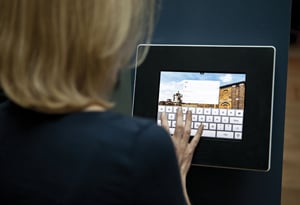iPaddy power
Ellie Manwell explains how bringing digital technology into the gallery space is helping Dulwich Picture Gallery enhance the visitor experience and connect with audiences

Recent advances in digital technology and social media have offered a wealth of opportunities to the museum and gallery world. At times these possibilities can seem overwhelming and it can be difficult to select the best opportunities available when resources are limited. Every institution has different directives and it is crucial to identify which digital developments can most-closely support these. It is useful to view these advances from two perspectives: enhancing the visitor experience; and maximising the potential to connect with current audiences as well as attract new ones.
Transforming the visitor experience has particular value in attracting new audiences at Dulwich Picture Gallery; a traditional art gallery whose collection of old master paintings are at risk of being perceived as only of interest to a traditional and learned audience. Of course, our collection is packed full of timeless themes and exciting stories but it is not always easy for audiences to engage with these.
It must also be said that, particularly in the past, introducing technology has proven challenging when concerns are raised about preservation of the integrity of the gallery space and its aesthetics, as well as cost implications.
The advent of the sleek and versatile iPad (and now many other similar tablets) has presented an incredibly versatile solution; one that’s a far cry from the large screens, booths or platforms of the past, and has allayed fears regarding disruption of the gallery’s aesthetics.
Our Communications team has devised three uses for the iPad: improving the visitor experience by hosting content associated with the current exhibitions; connecting more effectively with current and new audiences by digitising our mailing list subscription system; and encouraging visitors to convert traditional ‘word of mouth’ visitor feedback into social media content, essentially a digital visitor book.
Hosting content:
An iPad hosting video and audio content associated with the current exhibition is fixed on the wall at the entrance to the exhibition space. Housed in a sleek white case produced by Bounce Pad (which conceals the menu button), this iPad allows visitors to engage with digital content. For Ragamala Paintings from India it hosted examples of Ragas – an Indian melody on which each of the paintings was based, for the current Warhol exhibition it is hosting interviews and videos including Warhol’s cameos in various bizarre adverts in the ‘60s.
Collecting data:
On entering the Gallery visitors can input their data into an iPad via an easy to use application provided by MailChimp. This automatically feeds into our MailChimp database and removes the time consuming job of manually inputting data capture.
Gathering feedback:
Perhaps the most innovative and effective use of the iPad we have devised is the digital visitor book. Visitors are invited to input feedback about their visit into an iPad, with the field limited to 140 characters. Feedback is automatically fed into our review Twitter feed (@dulwichreview) and can then be harnessed by us and retweeted in the main feed (@dulwichgallery). Stuart Leech, Digital Communications Officer at the Gallery explains: “Research shows that word of mouth referrals are 2.5 times more effective than direct marketing methods and 92% of people prefer to have referrals and recommendations for products, services and people this way. Our digital visitor book which uses a web app developed in-house allows us to easily capture these positive referrals in viral form and maximise their distribution. It also allows us genuine insight into how our visitors are feeling during their visit.”
As digital technologies continue to develop the future holds exciting possibilities. We hope to develop child-orientated audiovisual guides of the permanent collection using touch screen technology, to offer alongside our current audiovisual guides that use traditional button operated technology. We also plan to reach out further, beyond the confines of the physical, to provide visitors with more ways of connecting with us virtually.
Join the Discussion
You must be logged in to post a comment.